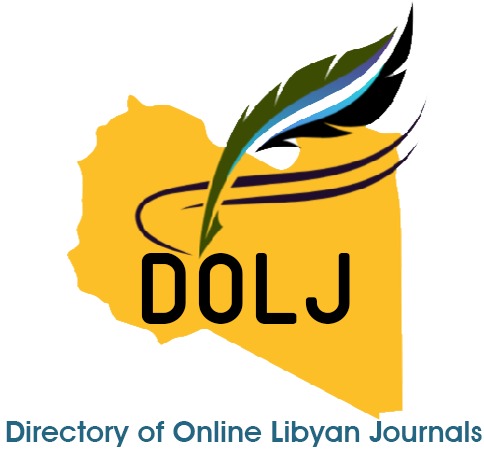Evaluation of Cladophora vadorum antimicrobial activity collected from Tabalino lakes in Benghazi city, Libya on human pathogenic bacterial isolates
DOI:
https://doi.org/10.37376/ljst.v12i1.7118Keywords:
Cladophora vadorum, anti-bacterial activity, pathogenic bacteria, algal extractAbstract
This study was conducted using Cladophora vadorum (green algae), collected from Tabalino lakes in Benghazi to evaluate the effect of this algae on the growth of four strains of bacteria (Staphylococcus aureus, Escherichia coli, Pseudomonas aeruginosa, and Klebsiella pneumonia) using 5 types of organic solvents (ethanol, acetone, methanol, petroleum ether, and ethyl acetate). The effect of organic solvent extracts on the growth of the bacteria used was varied. The petroleum ether extract was the most effective against the growth of all the bacteria used. Ethanol, Acetone, and ethyl acetate were active against at least one or two of the tested bacteria. The inhibitory effect on other bacteria was different. S. aureus was found to be more sensitive by all the organic solvent extracts used. E. coli has resistance and did not give positive results against extracts used except petroleum ether extract, while K. pneumonia bacteria was not affected by all types of organic extracts used. Presence of many active substances in Cladophora vadorum methanol extract supports their placement among medicinal plants because of their medically influenced compounds.
Downloads
References
Abdel-Raouf, N.; Mohamed, H. M.; Mostafa, S. S. and Ibraheem, B. M. (2017) ʻControlling of microbial growth by using Cys-toseira barbata extractʼ, J. Bot. 57 (3), pp. 469-477.
Adedayo, M. R., Ajiboye, E. A., Akintunde, J. K., & Odaibo, A. (2011) ʻSingle cell proteins: as nutritional enhancerʼ, Advanc-es in Applied Science Research, 2(5), pp. 396-409.
Alang, G.; Kaur, R.; Singh, A.; Budlakoti, P.; Singh, A. and Singlas, P. (2009) ʻAntimicrobial Activity of Ulva lactuca extracts and its fraltionsʼ, pha., 3, pp. 107-117.
Alghazeer, R.; Whida, F.; Abduelrhman, E.; Gammondi, F. and Naili, M. (2013) ‘In vitro antibacterial activity of alkaloid ex-tracts from green, red and brown macroalgae from the west-ern coast of Libya’, Afr. J. bio., 12(51), pp. 7086-7091.
Alghazeer, R.; Whida, F.; Abduelrhman, E.; Gammoudi, F., Azwai, S. (2013) ʻScreeing of antibacterial activity in marine green, red, and brown macroalgae from the western coast of Libya’, Nat. sci., 5(1), pp. 7-14.
Al-saif, S. S. A.; Abdel-Raouf, N.; El-wazanani, H. A. and Aref, I. A. (2014) ‘Antibacterial substances from marine algae isolated from Jeddah cost of Red sea. Saudi Arabia. Saudi’, J. Bio.S., 21, pp. 57-64.
Alshalmani, S. K.; Zobi, N. H. and Bozakouk, I. H. (2014) ʻAntibacterial activity of Libyan seaweed extractsʼ, Int. J. Pha. Sic. Res., 5 (12), pp. 5425-5429.
Cheesbrough, M. (1984) Medical laboratory manual for tropical countries .1st ed. The ford press, 1td.
Chew, Y. L.; Lim, Y. Y.; Omar, M. and Khoo, K. S. (2007) ʻAntioxidant activity of three edible seaweeds from two areas in southeast Asiaʼ, LWT-Food Science and Technology, 41(6), pp. 1067-1072.
Chronakis, I. S., & Madsen, M. (2011) Algal proteins. In Handbook of food proteins. Woodhead Publishing, pp. 353-394.
Crasta, P. J.; Raviraja, N. S. and Sridhor, K. R. (1997) ʻAntimicrobial activity of some marine algae of the southwest coast of Indiaʼ, Ind. J. mar. sci., 26, pp. 205-201.
Davison, J. M., & Cheyne, G. A. (1974) ʻHistory of the measure-ment of glucose in urine: a cautionary taleʼ, Medical history, 18(2), pp. 194-197.
El-Fatimy ES, Said AA, Godeh MM. (2009) ʻSeasonal variation and antifungal activities of methanolic algal extracts of some Dictyotaceae of Benghazi coasts, Libyaʼ, Egyptian Journal of Phycology, 10, pp. 1-9.
Godeh, M. M.; said. A. A.; El-menifi. F. O.; Zarmouh. M. Y. (2017) ʻMarine algae of Sert coasts, Libyaʼ, J. Sci. App. 5(1), pp. 41-44.
Godeh, M. M.; Said, A. A.; Zarmouh, M. M. and EL-Menifi, F. O. (2010) ʻMarine Chlorophyta of Benghazi coasts, Libyaʼ, J. Sci. Its. 4(1), pp. 7-13.
Godeh, M. M.; Nizamuddin, M. and El-menifi, F. A. (1992) ʻMarine algae from the eastern coast of Libya (Cyrenaica)ʼ, Pak. J. Bot., 24(1), pp.11-21.
Haddad D. (1965) The chemistry of vegetable drug. Cairo Univ. Press, Cairo.
Harborne, J. B. (1984) Phytochemical Methods: A guide to Modern Techniques of Plants Analysis. 2nd. Edt., Chapman & Hall, Lon-don, New York
Holdt, S. L., & Kraan, S. (2011) ʻBioactive compounds in seaweed: functional food applications and legislationʼ, Journal of applied phycology, 23(3), pp. 543-597.
Downloads
Published
How to Cite
Issue
Section
License
Copyright (c) 2024 Libyan Journal of Science &Technology

This work is licensed under a Creative Commons Attribution-NonCommercial-NoDerivatives 4.0 International License.










 LJST Copy rights form
LJST Copy rights form


